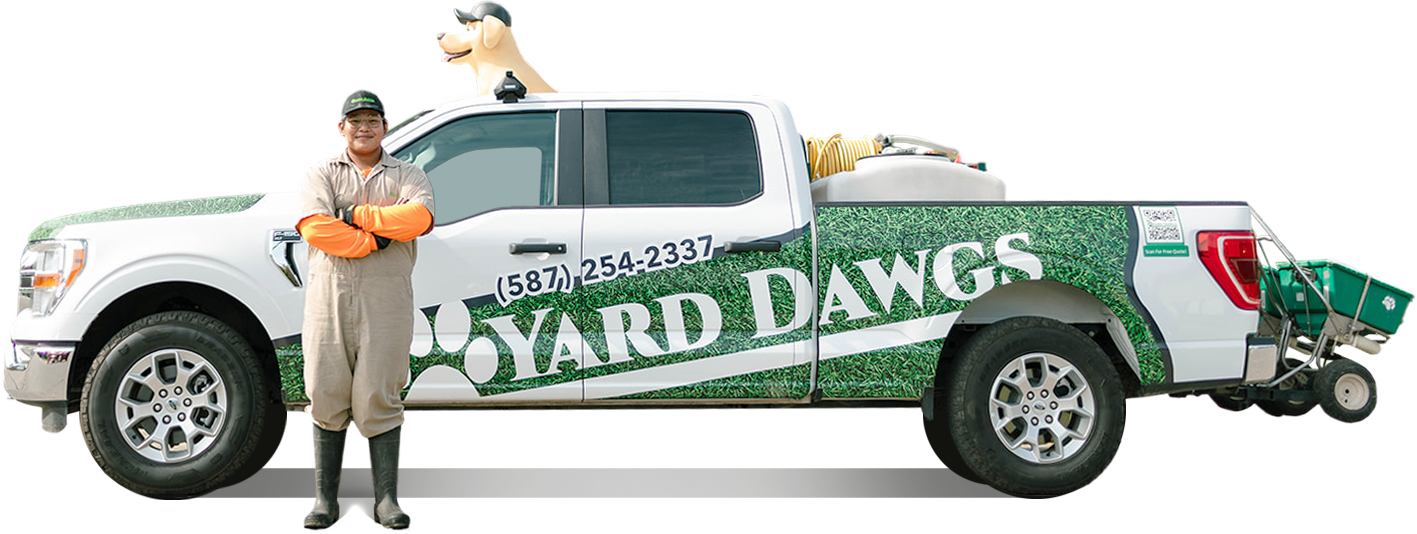What Is Clover?
Clover is a common weed that attracts insects and can be found in lawns that lack maintenance or nutrients. Because clover produces it’s own nutrients, it thrives in lawns that are undernourished. It is a perennial plant that grows everywhere. It’s white flowers and three leaflets beneath are easily identifiable. They grow in sparse lawns with little competition from grass. This plant flowers between April and September.
.png?width=675&name=Untitled%20design%20(26).png)
*Clover in your lawn will appear as this one does.
Clover is an incredibly resilient plant. It develops roots where the stem node touches the ground. It tolerates constant mowing, shade, foot traffic and are often found in lawns. Clover happily grows alongside other grasses. Once well established, they will become incredibly drought resistant and will not require regular watering. There is no requirement for soil quality because they create their own nutrients, clover does not rely on external climate conditions.

What Causes Clover In The Lawn?
If you have a clover assault on your grass, chances are your lawn is nitrogen depleted. Your grass requires nitrogen to grow and with a depleted soil, clover finds no competition. In fact, clover creates it’s own nutrients and therefore relies on no external climate conditions to grow. It will remain green long past your grass turns brown.
Secondly, clover is a perennial meaning it reoccurs every year. A perennial flower is a plant you’ll only plant once, it will come back year-to-year. Clover will plant itself and visit each year throughout the spring and summer. Their life cycle lasts more than two years. So, you can’t rely on the plant to die once the weather becomes too cold because you’ll see it again in April. Clover must be eradicated fully.
Clover thrives when you mow your grass short. Don’t think you’re killing it when you chop the top off. You’re only stressing out the grass in your lawn. Mowing at a higher level will give your grass an advantage – it “evens the playing field”.
What Are The Issues With Clover In Your Lawn?
.png?width=675&height=305&name=Untitled%20design%20(28).png)
*When clover blooms it looks like this. It will grow in a creeping fashion.
This invasive species attracts pests to your lawn. Rabbits love to feed on clover and any neighboring plants, such as garden flowers. Additionally, the white flowers attract insects, especially bees and wasps. As a lawn care company, we deal with clover often. One of our clients had an invasion in his backyard, most likely leaving his yard about 50% grass and 50% clover. After our weed control treatment not only was the clover greatly diminished, and eventually gone altogether, but his children felt safer playing in the yard. The grass came back in those areas and the wasps were gone.
Although clover is not necessarily an unattractive plant, problems stem from hosting this plant in your yard. With an under nourished soil, the clover in your lawn will outperform your grass and start to take over.
Benefits Of Clover
Once it begins to grow it does not require regular maintenance. Clover is also a naturally fertilizer, it pulls nitrogen into the soil. Additionally, it will fight off other harmful weeds – it’s an organic way to keep your lawn under control. However, it is not an attractive plant when it shows up in tufts and will attract bugs when the clover begins to flower.
How To Get Rid Of Clover in Lawn Naturally
How to remove clover from lawn can be a tricky task, but with the right methods, you can effectively control and eliminate it without resorting to harsh chemicals.
Raise Mowing Height
You can begin your fight against the plant by adjusting your mowing height. Clover has a shallow root system and grows close to the ground. If you raise the height at which you mow, you’ll create a shade cover for the clover. The taller grass will block sunlight and inhibit the clover from spreading. This is not a hundred percent effective for a couple reasons. Firstly, clover grows well in a number of different conditions, including shade. It also can invade such a vast area, that the grass surrounding cannot provide an effective shade cover.
Pull The Clover Manually
This strategy will only be successful if the invasion is mild. Gently loosen the soil and pull the clover out, making sure to remove the roots as well. If the roots remain so will the plant. You can complete this task with a spade.
Deprive The Clover Of Oxygen And Sunlight
This approach requires patience. The clover can be killed by placing plastic sheeting over top and covering the corners with rocks. After a few weeks your clover should be dead. However, anything else covered by the plastic sheeting will be killed as well. If your grass dies with the clover, there will be less competition for the clover to re emerge. Only use this method on large patches of clover.
Once you’ve successfully gotten rid of the clover in your lawn, it’s essential you put seed over the bare spots in your lawn. Without competition the clover will come back. Water the seed regularly to promote new growth.
Best Spray To Get Rid Of Clover In Your Lawn
Yard Dawgs has specialized in weed control for years. We’ve dealt with clover time and time again. Fortunately, it’s one of the easier plants to kill. Our product is formulated specifically for turf grass and has a three-way active ingredient to take out weeds. It controls both annual and perennial weeds, of which clover is the latter.
The active ingredient in our weed control causes the clover to grow at an uncontrollable rate. This destructs vital tissues in the plant. The weed essentially grows itself to death. It doesn’t affect grass because the weed control targets broadleaf weeds and not grasses. The growing point for weeds is at the tip of the plant whereas grasses grow from their base.
Another reason clover may be taking over your lawn is due to a soil that is too compacted. When soil is compacted it chokes the grass and deprives it of water, air, and nutrients. Because clover thrives in soil conditions of different natures there is no competition from the grass, and it begins to take over. Aeration is the best thing to battle a clay dense soil. You’re encouraging deeper root growth in your grass.
So, the best way to control clover in your lawn, or any weed for that matter, is to properly care for it. Stressed grass is less healthy, leaving ample room for weeds to take over.








.png)









